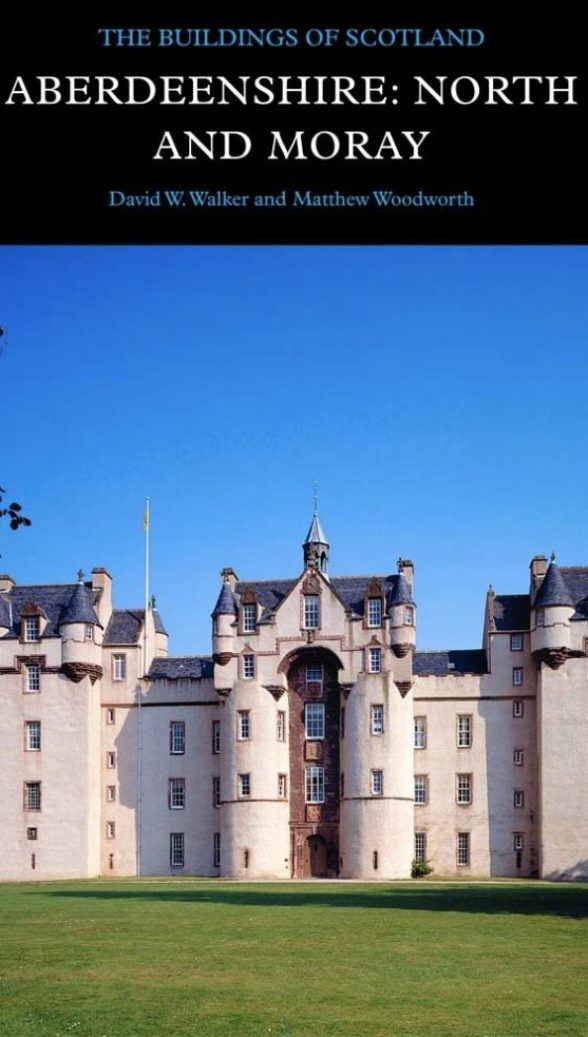This website uses cookies
This website uses cookies to enable it to function properly and to analyse how the website is used. Please click 'Close' to accept and continue using the website.


Aberdeenshire: North and Moray / Aberdeenshire: South and Aberdeen
David W Walker and Matthew Woodworth (Yale University Press, 817pp and 832pp, £35) and Joseph Sharples, David W Walker and Matthew Woodworth (Yale University Press, 817pp and 832pp, £35)
Reviewed by Liz Duthie

These Pevsner Buildings of Scotland volumes cover the whole North East, ‘a country in itself’: Aberdeenshire, Moray, and the former Banff and Kincardine. After the unique stone circles, Pictish stones, tower houses, competitive churches and confident public buildings in the long 19th century, the 20th century appears less distinctive.
C20 enthusiasm is certainly muted in North and Moray. Take the oil and gas installations at St Fergus. The RIAS Banff and Buchan guide (1990) provides an illustration and concise description of the Total buildings’ ‘acceptably technological imagery’ (Architectural Design Group, 1977). Buildings of Scotland has two paragraphs on the terminal’s functions and products, but no description of any building. Round the coast, the ‘late Baronial’ Dundarg (reputedly by Wing Commander David Vaughan Carnegie, 1937-38) is covered inside and out.
In South and Aberdeen, Charles O’Brien’s introduction and Joseph Sharples’ gazetteer are more expansive on the interwar Deco, moderne and modernist sport and leisure buildings. Sharples describes with enjoyment the Deco Northern Hotel (A G R Mackenzie, 1938-48) and the Beach Ballroom (Thomas Roberts & Hume, 1926), its pyramid roof crowned with a tempietto, as well as the cheerful reinforced concrete shelters – c.1963 – nearby. He is enthusiastic about the Aberdeen university successes – Crombie Hall (Robert Matthew & Johnson-Marshall, 1953-56), the Fraser Noble Building with a concrete sail dome (J Douglass Mathews & Partners) and the Library (schmidt hammer lassen, 2009-12),with an interior ‘as exhilarating as a Baroque church’. The ‘large and dreary’ or ‘weedy’ failures are identified too. The same spirit marks his entries on the Robert Gordon campus at Garthdee: the Miesian art school (D Michael A Shewan, 1964-66), the business school and library (Foster & Partners, 1997-98), and the health faculty (Halliday Fraser Munro, 2002), ‘if anything even more successful in its relationship with the landscape’. The developments of the oil boom are exemplified in the Total and Chevron headquarters (both Jenkins & Marr, 1977 and 1978-79): ‘shiny corporate modernism’ versus ‘preposterously inflated’ vernacular.
Both volumes cite the fine social housing and public buildings designed by municipal architects from 1920 on. North and Moray illustrates the neglected Tarlair tidal pool (John C Miller, Macduff burgh surveyor, 1929-31), ‘a place of bracing good cheer for the masses’ – incredibly glamorous to your reviewer in the 1950s. No mention of the construction material. South and Aberdeen gives a good account of the Foresterhill medical site, from stripped classical granite Infirmary (J B Nicol of Kelly & Nicol, 1928-36) to shell-like Maggie’s Centre (Snøhetta, 2013).
Public housing built after WWI was around 56 per cent of Scottish housing stock in 1981. In the two largest towns of North and Moray, it goes unnoticed except for brief references to ‘standard four-in-a-block’ flats, and vernacular or ‘more classical’ revival. The ‘high-quality’ inter-war social housing in Fraserburgh (burgh surveyor W F Hamilton) is for the reader to imagine or recall: 1930s maisonettes and a curved tenement, jolly ‘Swedish’ wooden cabins around a sloping green, 1950s granite ashlar semis with gardens. The RIAS guide has illustrations of the ‘contemporary tenements’ in Peterhead (Baxter Clark & Paul, 1968) and 1960s flats in Fraserburgh.
Aberdeen housing is better served. The reader can appreciate the differences between Kincorth, a post-war garden city (design, Robert Gardner-Medwin, Clifford Holliday, Denis Winston, 1937); Mastrick, 1952 onwards, with a shopping and community centre; and the late 1930s semis and timber flats at Garthdee, handy for the dignified former crematorium (Rollo & Hall, 1935-38). Like Owen Hatherley but with more context, Sharples values Rosemount Square (Aberdeen City Architects Department, 1938-48): an archway with relief by T B Huxley-Jones (1948) is illustrated. Post-oil housing is rightly passed over in silence except for Westhill, laid out on garden city principles from 1973.
Among the minor delights are J & W Wittet of Elgin, who were building Arts & Crafts in 1924, moderne in the 1930s, and Deco in 1947. Their ‘standard four-in-a-block’ 1930s council housing (illustrated in Historic Scotland’s Dictionary of Scottish Architects) has survived well.
In Aberdeen, the brutalist former Co-op (Covell Matthews & Partners, 1967-70) is ‘by a long way the most distinctive and impressive contribution of the 1960s to the city centre.’ Brutalism is less favoured in Moray. St Christopher’s Chapel at Gordonstoun (Murray, Ward & Partners, 1965-67) has canted wall sections around the perimeter ‘sensibly covered in curtains’; the WWII coastal battery near Lossiemouth, with ‘seemingly endless rows of anti-tank blocks’ does not invoke the sublime.
There is good coverage of war memorials, from ‘bravura Beaux-Arts classicism’ in Aberdeen (A Marshall Mackenzie & Son, 1919) to the landmark tower at Macduff (John Fowlie, 1921-22). Two modern distilleries are illustrated: Auchroisk (Westminster Design Associates, 1973-74), vernacular; Roseisle (Austin-Smith Lord, 2007-09), ‘colossal’ (and wonderfully so, from the illustration). The Aberdeen Marine Operations Centre (SMC Parr Architects, 2006), is ‘boldly functional’, a fine successor in the region where the first Scottish lighthouse was built in 1787.
We are still populating our book review section. You will be able to search by book name, author or date of publication.

Become a C20 member today and help save our modern design heritage.